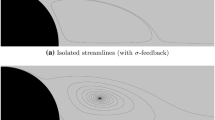Abstract
It is demonstrated that the continuity and irrotationality conditions imply geometric constraints for two-dimensional steady flows. This fact leads to the formulation of an exclusively geometric criterion for these kinematical conditions. Thus, flow visualization can be conclusive on whether a flow possesses a potential or not. Moreover, the mutual relationship among the flow geometry, its kinematics and physics, can be expressed mathematically using an eikonal equation. Its analytical solution in the flow-streamline coordinate system enables the formulation of the `Geometric Potential Theory’. Accordingly, the determination of the physical quantities of velocity and static pressure throughout the flow is reduced to the purely geometrical problem of finding the streamline and potential line curvatures. These two functions are combined to introduce the `Global Curvature Vector’, a vector that can be mathematically and physically interpreted. Finally, it is shown that continuity and irrotationality are identically satisfied by the existence of a `Curvature Potential’, that is, the existence of an analytic expression from which the global curvature vector components can be found by partial differentiation.
Similar content being viewed by others
References
Dimitriou I (2007) On the geometry of a steady two dimensional potential flow and its physics. Z Angew Math Phys 58: 100–120
Struik DJ (1988) Lectures on classical differential geometry, 2nd edn. Dover, ISBN 0-486-65609-8, pp 5–6
Martensen E (1968) Potentialtheorie. B. G. Teubner Stuttgart, pp 246–254
Kamke E (1974) II. Partielle Differentialgleichungen erster Ordnung für eine gesuchte Funktion. Chelsea Publishing Company, Bronx-New York, pp 62–77, 205–206
Kerho MF, Bragg MB (1994) Neutrally buoyant bubbles used as flow tracers in air. Exp Fluids 16: 393–400
Smits AJ, Lim TT (2000) Flow visualization: techniques and examples. Imperial College Press, pp 27–69
Maas HG, Gruen A, Papantoniou D (1993) Particle tracking velocimetry in three-dimensional flows—Part I: photogrammetric determination of particle coordinates. Exp Fluids 15: 133–146
Theisel H (1995) Vector field curvature and applications. Dissertation, Rostock University, pp 7–9, 15–19
Polthier K, Preuß E (2003) Identifying vector field singularities using a discrete hodge decomposition. Visualization and Mathematics III, Springer Verlag, pp 113–134
Author information
Authors and Affiliations
Corresponding author
Rights and permissions
About this article
Cite this article
Dimitriou, I. Introducing a Geometric Potential Theory for two-dimensional steady flows. J Eng Math 63, 1–15 (2009). https://doi.org/10.1007/s10665-008-9235-1
Received:
Accepted:
Published:
Issue Date:
DOI: https://doi.org/10.1007/s10665-008-9235-1




